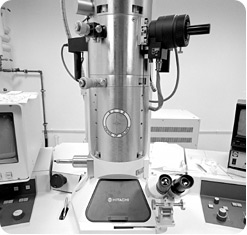|


What can a lab in London tell us about a jungle in
Belize? Find out when we broadcast live from the
scanning
electron microscope
(SEM) of London’s
Natural
History Museum
. You'll see the same stunning images
the scientists see, and learn how this powerful tool
is changing the way they do their work.
Researchers use the Natural History Museum's SEM to
study all kinds of specimens collected from locations
across the globe. Using a beam of electrons, the SEM
can magnify specimens hundreds of thousands of times,
and provide valuable information about the chemical
structure of everything from insects to minerals.
On our tour, you'll learn how the SEM is being used
in
palynology
,
the study of pollen, as palynologist Peter Stafford
and microscopist Chris Jones examine specimens collected
in
Belize
. By
comparing pollen from different species, these researchers
help trace the evolutionary relationships between many
of the jungle's plants. To do this work, Peter and Chris
use the same combination of observation and critical
thinking that
Darwin
used, now brought to new heights with the help of modern
technology.
|

|

|
